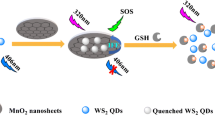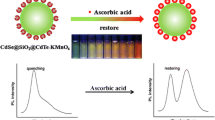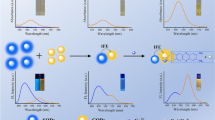Abstract
In order to detect ascorbic acid (AA) sensitively, a dual-signal optical sensor of a nanosystem with carbon dots (CDs)/MnO2 nanosheets based on fluorescence and second-order scattering (SOS) has been constructed. Here, MnO2 nanosheets, both as a fluorescence quencher and signal transducer of SOS, quench the blue fluorescence of CDs by an inner filter effect. Under the excitation of 300 nm, the nanosystem shows a fluorescence emission peak at 405 nm and a SOS peak at 610 nm, respectively. With the increase of AA , the lamellar structure of MnO2 nanosheets is etched into a smaller nanostructure, causing a decrease of the fluorescence recovery of CDs (405 nm) and decrease of the SOS signal of the MnO2 nanosheets (610 nm). According to the simultaneous changes of fluorescence and SOS signals, a dual-signal optical sensor toward AA is successfully constructed. Satisfactorily, the optical sensor for AA detection shows a detection limit of 88 and 105 nM for fluorescence and SOS, respectively. The practical application of the designed sensor is verified through the detection of AA content in vitamin C tablets, and satisfactory results are obtained

A dual-signal sensor of fluorescence (FL) and second-order scattering (SOS) based on the carbon dot (CD) and MnO2 nanosheet system for ascorbic acid (AA) detection is constructed, in which CDs are used for the FL mode and MnO2 nanosheets are used for the SOS mode.






Similar content being viewed by others
References
Hou X, Zhan G, Huang X, Wang N, Ai Z, Zhang L (2019) Persulfate activation induced by ascorbic acid for efficient organic pollutants oxidation. Chem Eng J 382:122355. https://doi.org/10.1016/j.cej.2019.122355
Yang YJ, Jo A, Lee YM, Lee CM (2018) Electrodeposited nanoporous ruthenium oxide for simultaneous quantification of ascorbic acid and uric acid using chronoamperometry at two different potentials. Sensors Actuators B Chem 255:316–324. https://doi.org/10.1016/j.snb.2017.08.089
Zhang LM, Qin J, Yang Q, Wei SQ, Yang R (2019) Redox modulated fluorometric sensing of ascorbic acid by using a hybrid material composed of carbon dots and CoOOH nanosheets. Microchim Acta 186:368–374. https://doi.org/10.1007/s00604-019-3483-9
Li N, Li YH, Han YY, Pan W, Zhang TT, Tang B (2014) A highly selective and instantaneous nanoprobe for detection and imaging of ascorbic acid in living cells and in vivo. Anal Chem 86:3924–3940. https://doi.org/10.1021/ac5000587
Barberis A, Spissu Y, Bazzu G, Fadda A, Azara E, Sanna D, Schirra M, Serra PA (2014) Development and characterization of an ascorbate oxidase-based sensor-biosensor system for telemetric detection of AA and antioxidant capacity in fresh orange juice. Anal Chem 86:8727–8734. https://doi.org/10.1021/ac502066a
Wang H, Pu GQ, Devaramani S, Wang YF, Yang ZF, Li LF, Ma XF, Lu XQ (2018) Bimodal electrochemiluminescence of G-CNQDs in the presence of double coreactants for ascorbic acid detection. Anal Chem 90:4871–4877. https://doi.org/10.1021/acs.analchem.8b00517
Porto ISA, Santos Neto JH, dos Santos LO, Gomes AA, Ferreira SLC (2019) Determination of ascorbic acid in natural fruit juices using digital image colorimetry. Microchem J 149:104031. https://doi.org/10.1016/j.microc.2019.104031
Li XN, Franke AA (2009) Fast HPLC-ECD analysis of ascorbic acid, dehydroascorbic acid and uric acid. J Chromatogr B 877:853–856. https://doi.org/10.1016/j.jchromb.2009.02.008
Bazel Y, Riabukhina T, Tirpák J (2018) Spectrophotometric determination of ascorbic acid in foods with the use of vortex-assisted liquid-liquid microextraction. Microchem J 143:160–165. https://doi.org/10.1016/j.microc.2018.08.003
Guo L, Liu Y, Kong RM, Chen G, Liu Z, Qu FL, Xia L, Tan WH (2019) A metal-organic framework as selectivity regulator for Fe(3+) and ascorbic acid detection. Anal Chem 91:12453–12460. https://doi.org/10.1021/acs.analchem.9b03143
Sidhu JS, Singh A, Garg N, Kaur N, Singh N (2019) Gold conjugated carbon dots nano assembly: FRET paired fluorescence probe for cysteine recognition. Sensors Actuators B Chem 282:515–522. https://doi.org/10.1016/j.snb.2018.11.105
Wang YL, Lao SY, Ding WJ, Zhang ZD, Liu SY (2019) A novel ratiometric fluorescent probe for detection of iron ions and zinc ions based on dual-emission carbon dots. Sensors Actuators B Chem 284:186–192. https://doi.org/10.1016/j.snb.2018.12.139
Peng C, Xing HH, Fan XS, Xue Y, Li J, Wang E (2019) Glutathione regulated inner filter effect of MnO2 nanosheets on boron nitride quantum dots for sensitive assay. Anal Chem 91:5762–5767. https://doi.org/10.1021/acs.analchem.8b05961
Zhu SM, Wang SC, Xia MM, Wang BJ, Huang Y, Zhang DX, Zhang XJ, Wang GF (2019) Intracellular imaging of glutathione with MnO2 Nanosheet@Ru(bpy)3(2+)-UiO-66 nanocomposites. ACS Appl Mater Interfaces 11:31693–31699. https://doi.org/10.1021/acsami.9b11025
Wang J, Peng X, Li DQ, Jiang XC, Pan ZF, Chen AM, Huang L, Hu J (2018) Ratiometric ultrasensitive fluorometric detection of ascorbic acid using a dually emitting CdSe@SiO2@CdTe quantum dot hybrid. Microchim Acta 186:42–50. https://doi.org/10.1007/s00604-017-2557-9
Achadu OJ, Revaprasadu N (2019) Tannic acid-derivatized graphitic carbon nitride quantum dots as an “on-off-on” fluorescent nanoprobe for ascorbic acid via copper (II) mediation. Microchim Acta 186:87–96. https://doi.org/10.1007/s00604-018-3203-x
Liu JJ, Chen YL, Wang WF, Feng J, Liang MJ, Ma SD, Chen XG (2016) “Switch-on” fluorescent sensing of ascorbic acid in food samples based on carbon quantum dots-MnO2 probe. J Agric Food Chem 64:371–380. https://doi.org/10.1021/acs.jafc.5b05726
Lin X, Hai X, Wang N, Chen XW, Wang JH (2017) Dual-signal model array sensor based on GQDs/AuNPs system for sensitive protein discrimination. Anal Chim Acta 992:105–111. https://doi.org/10.1016/j.aca.2017.09.006
Liu SG, Han L, Li N, Ju YJ, Li NB, Luo HQ (2018) Fluorescent and colorimetric dual-mode assay of alkaline phosphatase activity via destroying oxidase-like CoOOH nanoflakes. J Mater Chem B 6:2843–2850. https://doi.org/10.1039/C7TB03275G
Han L, Liu SG, Liang JY, Li NB, Luo HQ (2019) Free-label dual-signal responsive optical sensor by combining resonance Rayleigh scattering and colorimetry for sensitive detection of glutathione based on ultrathin MnO2 nanoflakes. Sensors Actuators B Chem 288:195–201. https://doi.org/10.1016/j.snb.2019.02.117
Yan X, Song Y, Zhu CZ, Li HX, Du D, Su XG, Lin YH (2018) MnO2 nanosheet-carbon dots sensing platform for sensitive detection of organophosphorus pesticides. Anal Chem 90:2618–2624. https://doi.org/10.1021/acs.analchem.7b04193
Han L, Liu SG, Zhang XF, Tao BX, Li NB, Luo HQ (2017) A sensitive polymer dots-manganese dioxide fluorescent nanosensor for “turn-on” detection of glutathione in human serum. Sensors Actuators B Chem 258:25–31. https://doi.org/10.1016/j.snb.2017.11.056
Huang S, Yang EL, Yao JD, Liu Y, Xiao Q (2018) Red emission nitrogen, boron, sulfur co-doped carbon dots for “on-off-on” fluorescent mode detection of Ag+ ions and l-cysteine in complex biological fluids and living cells. Anal Chim Acta 1035:192–202. https://doi.org/10.1016/j.aca.2018.06.051
Tian T, He Y, Ge YL, Song GW (2017) One-pot synthesis of boron and nitrogen co-doped carbon dots as the fluorescence probe for dopamine based on the redox reaction between Cr(VI) and dopamine. Sensors Actuators B Chem 240:1265–1271. https://doi.org/10.1016/j.snb.2016.09.114
Xiao N, Liu SG, Mo S, Li N, Ju YJ, Ling Y, Li NB, Luo HQ (2018) Highly selective detection of p-nitrophenol using fluorescence assay based on boron, nitrogen co-doped carbon dots. Talanta 184:184–192. https://doi.org/10.1016/j.talanta.2018.02.114
Xiao T, Sun J, Zhao JH, Wang S, Liu GY, Yang XR (2018) FRET effect between fluorescent polydopamine nanoparticles and MnO2 nanosheets and its application for sensitive sensing of alkaline phosphatase. ACS Appl Mater Interfaces 10:6560–6569. https://doi.org/10.1021/acsami.7b18816
Zu FL, Yan FY, Bai ZJ, Xu JX, Wang YY, Huang YC, Zhou XG (2017) The quenching of the fluorescence of carbon dots: a review on mechanisms and applications. Microchim Acta 184:1899–1914. https://doi.org/10.1007/s00604-017-2318-9
Liu YN, Wang QZ, Guo SW, Jia P, Shui YH, Yao SY, Huang C, Zhang M, Wang L (2018) Highly selective and sensitive fluorescence detection of hydroquinone using novel silicon quantum dots. Sensors Actuators B Chem 275:415–421. https://doi.org/10.1016/j.snb.2018.08.073
Zhu RF, Huang WY, Ma XF, Zhang YH, Yue CC, Fang WH, Zhao H, Li ZX (2019) Nitrogen-doped carbon dots-V2O5 nanobelts sensing platform for sensitive detection of ascorbic acid and alkaline phosphatase activity. Anal Chim Acta 1089:131–143. https://doi.org/10.1016/j.aca.2019.08.061
Liu LZ, Mi Z, Li HH, Li CQ, Hu Q, Feng F (2019) Highly selective and sensitive detection of amaranth by using carbon dots-based nanosensor. RSC Adv 9:26315–26320. https://doi.org/10.1039/c9ra04494a
Liu SG, Mo S, Han L, Li N, Fan YZ, Li NB, Luo HQ (2019) Oxidation etching induced dual-signal response of carbon dots/silver nanoparticles system for ratiometric optical sensing of H2O2 and H2O2-related bioanalysis. Anal Chim Acta 1055:81–89. https://doi.org/10.1016/j.aca.2018.12.015
Liu SG, Li N, Han L, Li LJ, Li NB, Luo HQ (2018) Size-dependent modulation of fluorescence and light scattering: a new strategy for development of ratiometric sensing. Mater Horiz 5:454–460. https://doi.org/10.1039/c7mh00872d
Ren W, Zhang Y, Chen HG, Gao ZF, Li NB, Luo HQ (2016) Ultrasensitive label-free resonance Rayleigh scattering aptasensor for Hg(2+) using Hg(2+)-triggered exonuclease III-assisted target recycling and growth of G-wires for signal amplification. Anal Chem 88:1385–1390. https://doi.org/10.1021/acs.analchem.5b03972
Li JB, Wang JH, Zhang XX, Chang HH, Wei WL (2018) Highly selective detection of epidermal growth factor receptor by multifunctional gold-nanoparticle-based resonance Rayleigh scattering method. Sensors Actuators B Chem 273:1300–1306. https://doi.org/10.1016/j.snb.2018.07.046
Wu ZH, Nan DY, Yang H, Pan S, Liu H, Hu XL (2019) A ratiometric fluorescence-scattered light strategy based on MoS2 quantum dots/CoOOH nanoflakes system for ascorbic acid detection. Anal Chim Acta 1091:59–68. https://doi.org/10.1016/j.aca.2019.09.054
Acknowledgments
This study was financially supported by the National Natural Science Foundation of China (No. 21675131, 21273174) and the Natural Science Foundation of Chongqing (No. CSTC-2015jcyjB50001).
Author information
Authors and Affiliations
Corresponding authors
Ethics declarations
Conflict of interest
The authors declare that they have no competing interests.
Additional information
Publisher’s note
Springer Nature remains neutral with regard to jurisdictional claims in published maps and institutional affiliations.
Electronic supplementary material
ESM 1
(DOCX 4323 kb)
Rights and permissions
About this article
Cite this article
Tang, Q., Fan, Y.Z., Han, L. et al. Redox induced dual-signal optical sensor of carbon dots/MnO2 nanosheets based on fluorescence and second-order scattering for the detection of ascorbic acid. Microchim Acta 187, 475 (2020). https://doi.org/10.1007/s00604-020-04459-5
Received:
Accepted:
Published:
DOI: https://doi.org/10.1007/s00604-020-04459-5




